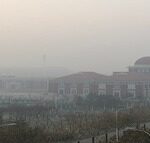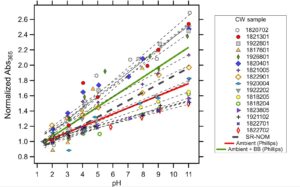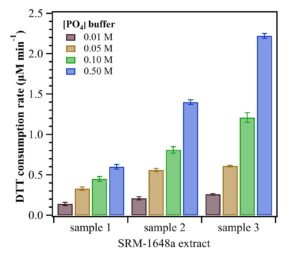Research in the Hennigan Lab aims to better understand the composition of the atmosphere and how this impacts human health and Earth’s climate. We are especially interested in aerosols (also called particulate matter, PM), small particles suspended in the atmosphere that have detrimental effects on human health and are important components in the climate system. Our work includes field measurements, laboratory experiments, and computational (modeling) approaches to characterize the following specific research areas:
Urban Air Quality:
A majority of the world’s population lives in urban areas, and the fraction of people living in cities is projected to increase substantially in the coming years. Our group studies air quality in urban areas, including the sources and factors contributing to air pollution events. At right, a photo of Tianjin, China (population 15 million) when the PM2.5 concentration was about 300 μg/m3, which is 20 times higher than the WHO guidelines for 24-hr average conditions.

Aqueous Atmospheric Chemistry:
There is a lot of liquid water in the atmosphere, in clouds, fog, and deliquesced aqueous particles. Significant chemistry can happen in the aqueous phase that cannot happen (or happens too slowly) in the gas phase. Aqueous chemistry has a dramatic impact on the composition and concentration of air pollutants in the atmosphere. At right is a figure from our paper (Hennigan et al., 2023) examining the effects of pH on chromophoric water-soluble organic carbon in cloud water.

Light-Absorbing Brown Carbon:
Aerosols scatter and absorb incoming solar radiation, with differing effects on Earth’s climate system. A class of chromophoric organic carbon – called brown carbon (BrC) – differs from other absorbing species (BC and dust) because it can be formed through chemical reactions of non-absorbing precursors and because it can undergo chemical reactions in the atmosphere that reduce its light absorption through a process called bleaching. Work in our group tries to understand the chemistry of atmospheric BrC, especially in aqueous environments like clouds. This photo showing visibly brown filters collected during summer 2023 when wildfire smoke from Canada impacted air quality in much of the eastern U.S., including in Maryland.

Particle Toxicity:
Measuring particle toxicity is key to understanding the health effects that have been associated with exposure to particulate matter. Our group studies the toxicity of different components present in PM, with a focus on metals and organics. We also carry out research on indoor air quality. This work will ultimately help us determine which sources of PM in both indoor and outdoor environments should be targeted for control. This figure from our paper (Yalamanchili et al., 2023) shows how a common assay used as a surrogate for particle toxicity increases with both the phosphate buffer concentration and the PM concentration.

Emissions:
We carry out studies to quantify emissions from major sources of air pollution. In the photo at right, we have deployed instruments to measure ammonia emissions from agricultural operations in central Maryland. We have also made measurements of urban air pollution sources and wildfire emissions, as examples.

See our Publications for more detailed information.